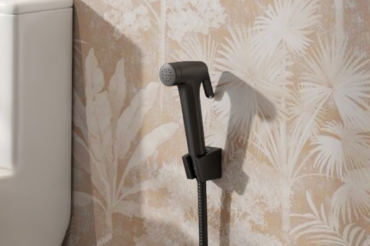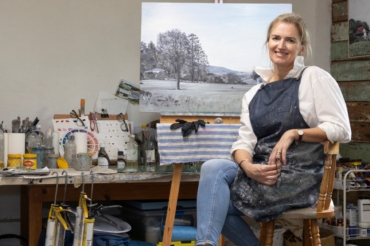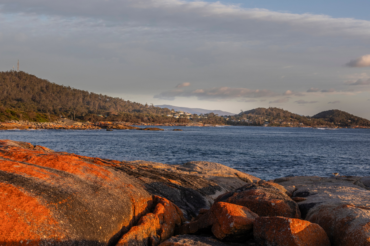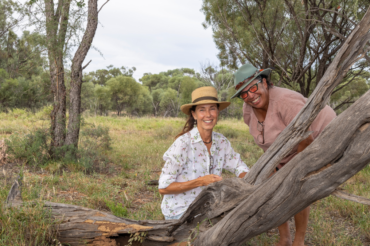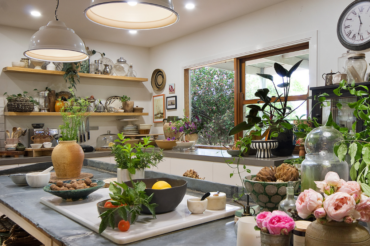
A SpaceX-like train of headlights beams through the early morning darkness as a convoy of maybe 100 vehicles makes its way from the Red Centre township of Yulara to the sunrise vantage point in Uluṟu National Park.

There’s a quiet determination in the visitors’ demeanour as they arrive in the designated carpark and walk briskly to (ever so-politely) jostle for a prime position on the elevated viewing platform. Slowly the magic begins as the sun’s first rays peek above the horizon and start to paint Uluṟu with a pastel wash. This natural spectacle is as close as many visitors to this part of the world will get to a metaphysical experience. It’s an event that’s made more remarkable by the fact that it’s repeated at the other end of the day from another viewpoint on the other side of Australia’s most famous landmark that measures almost 10 kilometres around the base and rises 300 metres above the ground. Whereas sunrise is a subtle show, sunset is a splashy statement as the golden hour saturates the landscape. Although named Ayers Rock by explorer William Gosse in 1873 for the then chief secretary of South Australia Henry Ayers, the site was known as Uluṟu for at least 30,000 years before that by the Traditional Owners, the Aṉangu people. Uluṟu and the 36 domes of Kata Tjuṯa (or the Olgas as explorer Ernest Giles named them in 1872) which are 50 kilometres away, are sacred to the Aṉangu, who continue to live there and, with Parks Australia, jointly manage the national park.

While the most direct way to visit the region is by flying into and out of the somewhat archaically named Ayers Rock Airport, many visitors choose to take a road trip, driving the sealed road 450 kilometres south and west from Alice Springs. Australian Country, however, opted for the slower and more scenic Red Centre Way, an almost 700km loop through the desert from Yulara – home to a raft of accommodation options run by Voyages Ayers Rock Resort – as well as an IGA, service station, food outlets and tour centre via Watarrka (Kings Canyon), and the Mereenie Loop Road to Tjoritja (the West MacDonnell Ranges) and Alice Springs. About 130km of this route is unsealed and although a 4WD is recommended, if you happen to hit the dirt just after it’s been graded, it would be totally doable in a conventional vehicle. You’ll need at least a week to even scratch the surface of this amazing region and probably double that to explore in a more relaxed manner.

There are many opportunities to learn about Uluṟu and Kata Tjuṯa from the Aṉangu people, beginning with a visit to the Cultural Centre, where there are Aboriginal art galleries and free daily presentations about traditional life and culture. We got lucky when we joined senior Aṉangu man and ranger Peter Wilson on the free guided Mala walk, actually more of a 2km-return stroll, but with his yarns, insights and laconic observations about white man’s obsession with dating everything and explaining the inexplicable, an hour and a half passes quickly. Along with showing visitors caves, rock art outlining the Mala story and explaining native flora and fauna, Peter tells a cautionary tale about the perils of ignoring the Traditional Owners’ deep knowledge of the land. He points to rampant buffel grass introduced from Africa as livestock fodder and explains how it has overtaken native pastures and now represents a severe bushfire risk. The Mala (or rufus hare wallaby) tale is an important creation story for the Aṉangu and Peter’s introduction is a great precursor to the after-dark Wintjiri Wiru experience. As custodians of the land, Aṉangu hold the Mala story from Kaltukarjara (Docker River) to Uluṟu. To share their story, light artist Bruce Ramus of RAMUS has designed and produced an artistic platform using drones, light and sound to create an immersive storytelling experience.

The ultra-modern interpretation of this ancient story, which involves 1200 drones and lasers dancing across the night sky, is a true spectacle and comes with several picnic hamper options with a focus on Indigenous ingredients. The following night, we are again tripping the light fantastic as almost 50,000 glass spheres on stalks gently bloom into colour at nightfall. Our experience of installation artist Bruce Munro’s Field of Light begins with bubbles and canapes on a viewing platform positioned to capture views of sunset on Uluru. The evening continues to an outdoor dining area where a three-course buffet dinner is served, along with sides of musical entertainment and a guided tour of the night sky. But the best is saved for last, when guests are allowed to walk around the extraordinary installation, which covers an area equivalent to seven football fields and is entirely powered by solar energy. There are options that don’t involve dining for those watching the budget or travelling with children.

By day, there are myriad other ways to explore the national park with numerous walking tracks including the Uluṟu base circuit walk. This track can also be navigated by hired pushbike, or guided Segway tours. Camel rides are also available as are helicopter and fixed wing light aircraft flights over the landmark features. For those seeking refuge from the sometimes fierce heat of the midday sun, Voyages Ayers Rock Resort provides a raft of free entertainment that includes a bush food experience, storytelling sessions, animal painting and didgeridoo playing workshops and a screening of Capturing the Cosmos followed by a talk and a Q&A with the resort’s resident astronomy guide. A visit to GoCA, the Gallery of Central Australia is a must for anyone with an interest in Aboriginal art.

From Yulara, it’s a cruisy 300km on sealed roads to Watarrka (Kings Canyon) first east via Lasseters Highway, then north and west on Luritja Drive. There’s not much to break the drive, apart from the roadhouse at Curtin Springs and a lookout for viewing Artilla (Mt Conner), a huge table-top formation that rises 300 metres above the landscape is sometimes alluded to as Fooluru, for its resemblance to its more famous sibling. Long relegated as the secondary attraction of the Red Centre, Watarrka National Park, home of Kings Canyon in the George Gill Range, is finally emerging as a destination in its own right with many visitors making the effort to trek the canyon’s Rim Walk, made famous by the sweet-voiced Australian Youth Choir’s performance on the escarpment as part of an extravagant Qantas ad. Yet others, including a German tourist we encounter as we pause for breath on the rocky 500-step ascent, are
inspired to visit by a completely different arts experience.

“I saw [drag queens] Mitzi, Felicia and Bernadette in Priscilla Queen of the Desert,” she explains. “So here
I am.” A parks ranger we encounter later on the 6km hike, which is supposed to take three to four hours, but, with photo stops and cautious navigation of the uneven surfaces, took us more like five, says there’s an annual event when trainers, T shirts and shorts come off and heels and gowns are donned for a recreation of that fabulous feather-bedecked cinematic moment. If the Rim Walk seems a bit daunting, the much easier Canyon Floor Walk provides a taste of the site’s scale. Or you can opt for a bird’s eye view with a scenic helicopter flight. Back at Discovery Resorts, Kings Canyon there’s a treat to be had for the price of a drink at the Luritja Lookout viewing platform. As the sun sets on Carmichael’s Crag, at the western end of the range, Bruce Munro’s most recent enhancement of the outback landscape, Light-Towers, comes to life. A circular maze of 69 two metre towers, each made from more than 200 recycled bottles filled with optic fibres, bathes the foreground in a kaleidoscope of colour to a soundtrack by Orlando Gough.

Ticketed events with food and beverage packages at dawn and dusk allow guests to walk among the towers. The resort offers many accommodation options from campground and glamping tents to deluxe rooms complete with freestanding bathtubs positioned to frame private views of the bush outside. From Kings Canyon, the Red Centre Way enters its most challenging section, the 130km unsealed part north and east known as the Mereenie Loop Road. There’s no fuel available until Alice Springs, so be sure to leave Kings Canyon with a full tank, plenty of water and snacks for the trip, particularly in case of emergencies. This route is beyond the land of the mobile phone, though on the day Australian County traversed it, the road was in good condition and maybe 15 other vehicles were using it. Other sightings along the way included a few dry-witted road signs, wild horses and camels, plus the occasional abandoned van and vehicle that didn’t make the distance. The absolute highlight, however, is the chance to visit Tnorala (Gosse Bluff) a 5km-diameter crater gouged in the earth some 142.5 million years ago when scientists believe comet hit the ground. This is a site of great cultural significance to the Western Arrernte people, not to mention interest for the scientific community. Interestingly, both interpretations of the place have celestial origins. You can view it from a lookout or take a short detour from the loop road to drive into the crater itself.

Rejoining the bitumen, there’s a choice to be made in terms of the route to Alice Springs (Mpawrntwe): Head east via the Hermannsburg Historic Precinct, home to the Namatjira school of watercolour painters or track north and then east via the gorges and waterholes of Tjoritja (West MacDonnell Ranges). We chose to make a very long day of this drive, by taking the latter option. With the 20/20 vision of hindsight, it may have been more sensible to head straight for Alice and explore the West Macs on a separate day trip. Tjoritja is a landscape of superlatives, and it can be explored in depth by walking the Larapinta Trail. There are camping grounds at some sites and cafes at Ormiston Gorge and Standley Chasm (Ankerle Atwatye), which also offers the opportunity to join a cultural tour led by a Traditional Owner. At press time, the entire precinct at Glen Helen Gorge was closed, so Ormiston Gorge, with its chilly but inviting swimming hole, was well patronised. You can’t miss the looming form of Mt Sonder, believed to resemble a supine pregnant woman, while the Ochre Pits, Serpentine Gorge and Ellery Creek Big Hole are
other great detours.

The eucalypt-lined sandy river bed leading to Simpsons Gap is a personal favourite, but even that’s a bit like being asked to choose a preferred child. Last stop before town is Flynn’s Grave, a giant boulder poised on a plinth with the ranges in the background in acknowledgment of the remarkable work of the Reverend John Flynn, the founder of the Australian Inland Mission and in the Royal Flying Doctor Service.
Visitors can learn more about Flynn and his ‘mantle of safety’ for outback people by calling in at the Royal Flying Doctor Service Tourist Facility in Alice Springs. Other links to the history of this stunningly located town, ringed by ranges and with the (mostly dry) Todd River bisecting it, can be experienced at the Overland Telegraph Station, remnant of an ambitious program in the 1870s to build a telegraph line from Adelaide to Palmerston (now Darwin) and ultimately link Australia with the rest of the world. Further opportunities to explore the frontier town’s European foundations can be found at the Old Hartley
Street School, now the HQ for the National Trust, the Women’s Museum of Australia and the Central Australian Aviation Museum, which is located at the Araluen Arts Precinct. Another reason to visit the precinct is to see the permanent and temporary exhibitions at the Araluen Arts Centre, which includes a significant collection of Aboriginal art. If that piques your interest, there are many opportunities to see and buy works by local artists. Be sure to visit the Yubu Napa Art Gallery, the Mbantua Art Gallery (bookings required) and Tjantpi Desert Weavers.

Alice Springs is also well served as a performing arts centre and there are various festivals throughout the year including the Desert Song Festival and Parrtjima, an annual celebration of light, music and performance. Also check for shows by Alice’s GUTS Dance, a contemporary dance company. Head to the Alice Springs School of the Air for an important insight into the lives of outback children, who are educated by a remarkable combination of the latest communications technologies and dedicated ‘on-air’ teachers. The studios of the world’s largest classroom, which covers an area of 1.3 million square kilometres, or twice the size of France, are open every day of the year except during the week between Christmas and New Year. Time your visit during school hours and you’ll see a teacher taking class via computer and satellite link. Drop in on Thursdays and meet Alice Springs author and lawyer Tanya Heaslip, a graduate of this wonderful education system and learn about her extraordinary childhood and later achievements, kick-started by her experience of education by radio. Alice Springs has the full gamut of accommodation choices from five-star hotels to caravan parks, but there are a couple of very special places located just out of town.

Red Desert Views is a converted shipping container, albeit a very fancy one, at Ross about 10km from town. Ooraminna Station is a bit further out, about 40km south of Alice, but well worth the trip to the resort set in a stunning location on a working station. The 600-acre (243-hectare) property includes a recreated frontier town remnant from a film set built for the uncompleted movie version of the song, The Drover’s Boy. Accommodation includes a campground, glamping in bell tents and several rustic cottages, there’s a horizon pool with livestock roaming by, and meals are served in a central White Horse Bar & Grill. The absolute highlight of a visit to the station, however, is the chance to head for a hilltop perch to watch sunset over the escarpments of the MacDonnell Ranges. And then the greatest show on earth begins, as the night sky fills with the magical haze of the Milky Way. With few artificial lights to detract from the spectacle, it’s a rare chance to see the galaxy in all its glory, proof, yet again, that no matter how hard we might try, man will never upstage nature.


